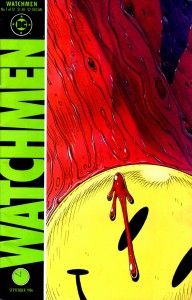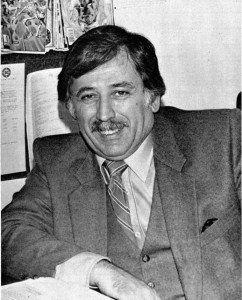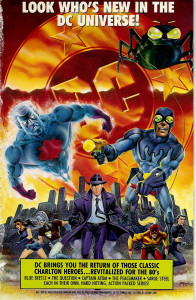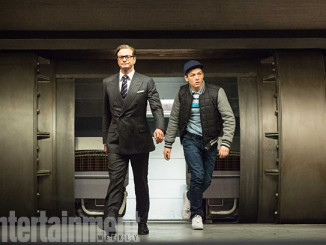In a multi-part series, Comic Book Film Editor William Gatevackes will be tracing the history of comic book movies from the earliest days of the film serials to today’s big blockbusters and beyond. Along with the history lesson, Bill will be covering some of the most prominent comic book films over the years and why they were so special. Today, we continue our profile of Alan Moore and take a look at film adaptation of one of his most political works.
 Watchmen is the most important work in comic book history. It is the medium’s Citizen Kane, its White Album, its Sopranos, and it’s Catcher in the Rye. It is not only another example of how comic books were not exclusively for kids anymore, but also that comic books can honestly be considered a form of literature. If you have an argument with that, I direct you to Rolling Stone, Spin and Time magazines, or any of the university professors who built curriculum around the work. Watchmen changed the world of comics forever, spawned a multitude of imitators, and influenced everything that came after it for both better and worse. It was definitely the most important work in modern comic books, and you’d find little argument if you said that it was the most important comic book series of all time.
Watchmen is the most important work in comic book history. It is the medium’s Citizen Kane, its White Album, its Sopranos, and it’s Catcher in the Rye. It is not only another example of how comic books were not exclusively for kids anymore, but also that comic books can honestly be considered a form of literature. If you have an argument with that, I direct you to Rolling Stone, Spin and Time magazines, or any of the university professors who built curriculum around the work. Watchmen changed the world of comics forever, spawned a multitude of imitators, and influenced everything that came after it for both better and worse. It was definitely the most important work in modern comic books, and you’d find little argument if you said that it was the most important comic book series of all time.
And it all came about because Alan Moore wanted to write a murder mystery about a group of established superheroes.
 In 1982, Moore started writing his reboot of Marvelman, a 1950’s British superhero created by Mick Anglo that was strongly based on the Fawcett hero Captain Marvel, for Britain’s Quality Publications comic Warrior. Moore took the light-hearted character and remade him into a darker, more serious look into the corruptive nature of superpowers. However, legal pressure from Marvel Comics of the character’s name caused Warrior to drop the strip in 1984.
In 1982, Moore started writing his reboot of Marvelman, a 1950’s British superhero created by Mick Anglo that was strongly based on the Fawcett hero Captain Marvel, for Britain’s Quality Publications comic Warrior. Moore took the light-hearted character and remade him into a darker, more serious look into the corruptive nature of superpowers. However, legal pressure from Marvel Comics of the character’s name caused Warrior to drop the strip in 1984.
In 1985, Eclipse Comics, an independent publisher located in the U.S., renamed the character Miracleman, reprinted the Warrior stories and brought Moore back to finish his run on the character. Moore by this time was well into his storied run on Saga of the Swamp Thing and, perhaps inspired by returning to his complete overhaul of the campy Marvelman, decided to use his new found influence to do the same thing with another group of characters.
 Moore’s idea was to build a murder mystery around the Mighty Crusaders, an extremely campy superhero team that was originally developed and featured in books published by Archie Comics publications. It is not known if DC had a license with Archie for the characters at the time (they would publish their take on the characters in 1992 and again in 2009), DC did buy the rights to the superhero characters from another defunct company, Charlton Comics in 1983. The characters were created in part at Charlton by Dick Giordano, who was managing editor at DC in 1983. The Charlton characters started making appearances in DC Comics starting with 1985’s Crisis on Infinite Earths.
Moore’s idea was to build a murder mystery around the Mighty Crusaders, an extremely campy superhero team that was originally developed and featured in books published by Archie Comics publications. It is not known if DC had a license with Archie for the characters at the time (they would publish their take on the characters in 1992 and again in 2009), DC did buy the rights to the superhero characters from another defunct company, Charlton Comics in 1983. The characters were created in part at Charlton by Dick Giordano, who was managing editor at DC in 1983. The Charlton characters started making appearances in DC Comics starting with 1985’s Crisis on Infinite Earths.

Moore quickly reworked his proposal to feature the Charlton characters and submitted it to Giordano. Giordano, hoping that the Charlton characters would become part of the DC Universe and realizing that Moore’s proposal would kill some of them off and make the rest unusable in the mainstream continuity, rejected the proposal. However, he knew Moore was onto something, and encouraged the writer to once again rework the pitch, only this time with his own characters.
So, the bug-themed Blue Beetle became the owl-themed Nite-Owl. Captain Atom, the military technician who gained god like powers from a nuclear accident, became Dr. Manhattan, a military scientist who gained god like powers from a nuclear accident. And the trench coat-wearing, reactionary, faceless vigilante The Question became Rorschach, a trench coat-wearing, reactionary vigilante who hid his identity behind a featureless mask with an ever changing design.
 The fact that Watchmen was based on pastiches of Charlton characters, in addition to elements as diverse as the Outer Limits episode “The Architects of Fear”, EC horror comics from the 1950s, and Robert Mayer’s 1977 novel Superfolks being included in the mix, has been used by critics as a bludgeon against the work, as if having obvious influences makes Moore and artist Dave Gibbons’ accomplishments on the series less grand. It doesn’t.
The fact that Watchmen was based on pastiches of Charlton characters, in addition to elements as diverse as the Outer Limits episode “The Architects of Fear”, EC horror comics from the 1950s, and Robert Mayer’s 1977 novel Superfolks being included in the mix, has been used by critics as a bludgeon against the work, as if having obvious influences makes Moore and artist Dave Gibbons’ accomplishments on the series less grand. It doesn’t.
I was able to pick up the series as it was released. I was only a teenager, so the story rocked my mind. It was a darker and more cynical take on the superhero, placing them in a “real world” setting. As young as I was, even I was able to pick up on the commentary the series was making on the state of Cold War brinkmanship, something that was coming back into vogue with Ronald Reagan as president. Later, I came to appreciate Dave Gibbons’ artwork, especially in issue #5, the symmetrical issue. I was able to enjoy the homage to EC Comics that runs through the book in everything from the “Tales of the Black Freighter” to Gibbons’ panel structure.
 Moore and Gibbons’ work on the series didn’t just push boundaries; it destroyed them and constructed new boundaries to reach—for good and bad. They opened the doors for other British creators such as Neil Gaiman (who lent a hand as a fact checker on the series), Grant Morrison, Steve Dillon and many more to gain a foothold on our shores. It was fundamental in establishing an environment where DC could feel comfortable creating the Vertigo imprint to house more literate takes on their characters and concepts. But Watchmen also inspired less skilled creators, those who didn’t quite get the nuances behind Moore and Gibbons’ real world take in the book, to try to ape the duo’s success by making their books darker and grittier without much in the way of substance added in the process.
Moore and Gibbons’ work on the series didn’t just push boundaries; it destroyed them and constructed new boundaries to reach—for good and bad. They opened the doors for other British creators such as Neil Gaiman (who lent a hand as a fact checker on the series), Grant Morrison, Steve Dillon and many more to gain a foothold on our shores. It was fundamental in establishing an environment where DC could feel comfortable creating the Vertigo imprint to house more literate takes on their characters and concepts. But Watchmen also inspired less skilled creators, those who didn’t quite get the nuances behind Moore and Gibbons’ real world take in the book, to try to ape the duo’s success by making their books darker and grittier without much in the way of substance added in the process.
Watchmen is Alan Moore and Dave Gibbons’ lasting legacy in comics, but a bittersweet one at that. When they made the agreement to do the series with DC Comics, they were promised that they would get ownership of the property once it went out of print. This seemed like a sweetheart of a deal because at the time, there wasn’t much of a secondary market after miniseries were completed so Moore and Gibbons thought it only natural that their series would end with its last issue and then the rights to the concept would be theirs. But by the time Watchmen completed, DC was well on its way to establishing its trade paperback program, where it would collect pivotal series like Frank Miller’s Batman; The Dark Knight Returns and even Alan Moore’s run on Swamp Thing into thick, cardboard covered books. Watchmen was collected into a trade paperback two months after the series ended, and was regularly reprinted ever since, meaning the story never went out of print (and would likely never do so) and Moore and Gibbons would never get the rights promised to them (and likely never would).

Moore would claim that DC pulled a fast one on him and Gibbons, with what I saw as an implication that DC kept the trade paperback in print just to keep him from getting his hands on the rights. But Alan Moore has only himself to blame. Watchmen is kept in print for the same reason the works of Shakespeare are kept in print or the works of Hemingway are kept in print. It is kept in print because it is a timeless classic that there will always be a new audience hungry for.
Watchmen revolutionized comic books from its very first issue and captured Hollywood’s attention almost immediately. Producer Lawrence Gordon bought the film rights to the property in 1986 from DC Comics, quite a ways before the miniseries even finished. As you know, the film didn’t actually make it to the big screen until 2009, and its arduous trek to the big screen is a story in and of itself, one that we’ll get to in our next installment.





FilmBuffOnLine liked this on Facebook.